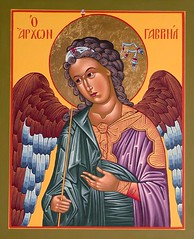Nicea II based its argumentation upon the writings and argumentation of Ss. Theodore of Studium, Germanus of Constantinople, and John of Damascus. St. John of Damascus’ famous treatise in defense of holy icons forms the basis for the argument below. I will also include some quotes from various Fathers defending images, showing that this is part of the undivided practice and faith of the church.
Two points refute this:
 First, the Commandment specifically mentions heaven, earth, sea, etc. God seems to be pointing out the type of worship the Israelites encountered in their pagan neighbors like Egypt, Babylonia, Philistia, Canaan, etc. In other words, “heavens,” meaning astrology, “earth,” meaning animism and nature worship, and “sea” meaning various forms of aquatic idolatry, such as Nile worship. So, God is not railing against the inherent evil of an image, but against the practices of the Israelite neighbors, which included any or all of the above.
First, the Commandment specifically mentions heaven, earth, sea, etc. God seems to be pointing out the type of worship the Israelites encountered in their pagan neighbors like Egypt, Babylonia, Philistia, Canaan, etc. In other words, “heavens,” meaning astrology, “earth,” meaning animism and nature worship, and “sea” meaning various forms of aquatic idolatry, such as Nile worship. So, God is not railing against the inherent evil of an image, but against the practices of the Israelite neighbors, which included any or all of the above.- Second, God himself commands many holy images to be placed inside the Holy of Holies! 1 Kings 6 describes how ornate the inside of the Holy of Holies was, replete with images of Cherubim and Seraphim, and of course the Ark itself had two huge, golden Cherubim over its lid.
 2. Following in this same train, when the Israelites were in the wilderness and were bit by the snakes, God commands Moses to make an image of a bronze serpent and put it on a pole and all the Israelites are to look in faith to this image. This is recounted in Numbers 21. Once again, this is clearly a religious image because Jesus explains it as a type of His crucifixion in John 3:14-15. All who will look to His Holy Cross will be saved from the bite of the real serpent, the devil. So, we have here a vindication of the use of the crucifix. That’s why St. Paul sees power in the Cross of Christ (see Colossians 2:13-15) to disarm the devil’s fallen hierarchy of fallen angels. That’s why crucifixes are used in exorcisms. And it's a rare church that doesn't have a single cross in the place.
2. Following in this same train, when the Israelites were in the wilderness and were bit by the snakes, God commands Moses to make an image of a bronze serpent and put it on a pole and all the Israelites are to look in faith to this image. This is recounted in Numbers 21. Once again, this is clearly a religious image because Jesus explains it as a type of His crucifixion in John 3:14-15. All who will look to His Holy Cross will be saved from the bite of the real serpent, the devil. So, we have here a vindication of the use of the crucifix. That’s why St. Paul sees power in the Cross of Christ (see Colossians 2:13-15) to disarm the devil’s fallen hierarchy of fallen angels. That’s why crucifixes are used in exorcisms. And it's a rare church that doesn't have a single cross in the place.
(Ironically, many will allow an American flag - replete with eagle at the top, symbol of Roman power - to be in their places of worship without a peep!)
3. The Bible itself is full is symbolism, which is merely another form of the use of images. Thus, the Holy Spirit appears in the form of a dove at Christ’s baptism. A dove, then, is legitimately used as an image of the Holy Spirit. The paschal lamb is an image of Christ, and so on. God presents Himself to us in Scripture through a variety of images. Human fathers, then, are an image of our heavenly Father. St. Paul, in Colossians 1:15, says that Christ is the image (Greek is “ikon”) of the invisible God. It was, in fact, the Jews who were enraged at Christ’s claim of divinity, a claim that provoked their erroneous zeal against holy images. How could the invisible Jehovah be Incarnate in a human image? To the Pharisees this was idolatry. But the catholic view gives due honor to the Incarnation by recognizing the validity and holy nature of images as part and parcel of the Incarnation, and this was the reasoning of Nicea II.
5. In Acts 19:11-12, cloths and handkerchiefs are touched by St. Paul, and are then placed upon those possessed and the spirits are driven out by these “relics.” Likewise, the woman with an issue of blood touches the hem of Jesus’ garment and “virtue goes forth from him” to heal her. The bones of Elisha even resurrect a dead soldier (2 Kings 13): this is the entire principle behind relics. Things–matter–stuff can be consecrated/sanctified for a holy purpose. Thus, Jesus spits in the sand and makes clay, rubbing it on the blind man’s eyes to heal him. Jesus could have simply spoken a word and healed the man, but in this instance He chose to use mud–stuff, to do the miracle. We call this the “Incarnational Principle.” It is the same thinking behind all sacramental practice.
6. Likewise, in the OT period, even places were holy. Places like Mt. Sinai, the Temple, etc. But this practice is not rejected in the NT, contrary to what many Protestants may think. In John 5, there is a pool where an angel stirs up the water and the first to enter the pool is healed. This is the principle behind shrines and healing icons. In 2 Peter 1:16-18, St. Peter calls the mountain that he witnessed the transfiguration on the “holy mountain.” So, even in the New Testament the principle of holy places is not abolished as something strictly Old Testament. One sees, then, that there is biblical basis for the catholic practices of relics, images and icons. If there is discernment, it must lie not with strict prohibition, but with regard to application.
 7. The Early Church Fathers are also very clear:
7. The Early Church Fathers are also very clear:
“We do not worship, we do not adore [non colimus, non adoramus], for fear that we should bow down to the creature rather than to the Creator, but we venerate [honoramus] the relics of the martyrs in order the better to adore Him whose martyrs they are.” Against Riparium -St. Jerome
“We by no means consider the holy martyrs to be gods, nor are we wont to bow down before them adoringly, but only relatively and reverentially.” Against Julian -St. Cyril of Alexandria
“We, the Christian community, assemble to celebrate the memory of the martyrs with ritual solemnity because we want to be inspired to follow their example, share in their merits, and be helped by their prayers. Yet we erect no altars to any of the martyrs, even in the martyrs’ burial chapels themselves.”
Even the incense that is sometimes burned in front of ikons is merely a reiteration that we believe the whole church triumphant prays for us and cheers us on in our run of faith. The saints themselves forbid anyone to offer them the worship they know is reserved for God, as is clear from the case of Paul and Barnabas. When the Lycaonians were so amazed by their miracles that they wanted to sacrifice to them as gods, the apostles tore their garments, declared that they were not gods, urged the people to believe them, and forbade them to worship them.

The truths we teach are one thing, the abuses thrust upon us are another.
heavy h/t to Jay Dyer






5 comments:
Thanks, Father!
Thank you! I appreciate you doing so much heavy lifting on your site. Like you, I came from a Reformed background and was overwhelmed with the simple catholicity of the Nicene Creed (without further need of punctilious Confessionalism).
On a pilgrimage to England, I was won over to the catholic faith. England is, by all conciliar agreements, the oldest of Churches outside of the Holy Land. The apostolic line of my bishop is only three generations removed from the Roman Church (Duarte Costa succession).
Who is the author of this?
Mr. Dyer, a convert to Roman Catholicism - I geared down some of the "Protestants this/that" language because it was needlessly galvanizing, and it's untrue. (Anglicans are Protestant, so are Lutherans, and yet both make use of iconography). Kevin and I have been dialoguing about icons and I found these reflections cogent.
I'm not sure I can go as far as relics (though in the charismatic churches they often pass out blessed hankies based on Paul's cited healings). In some ways, I think anti-Papal squeamishness controlled "reforms" made (especially on the Continent, though also in the second wave of the English Reformation); these culturally and politically agitated allergies undercut serious - and humble - reflection on what it means to be part of a received faith.
Based on the testimony of Nicea II, the unbroken practice of the Church, and their edifying use in multiple cultural contexts, and the warrant found in the Scriptures, I do not believe that the 2nd Commandment is violated by the use of images for teaching. I think it would be imprudent to try and image the Godhead, though representations of the Spirit as a dove and of Christ (the ikon of God) seem to be acceptable.
Chris,
Good points, but you know the more Reformed than thou types will have kittens if or when they read this. Remember how I was called a "Papal Yes Man?" Yuk Yuk.
John
Post a Comment